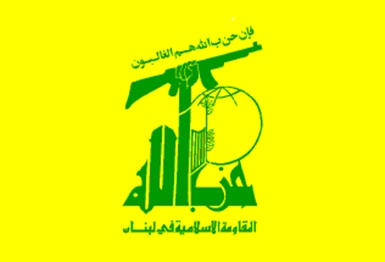
A day or two ago, Abu Muqawama asked whether the Hizballah flag showed an AK-47, and in general what flags carried what weapons as emblems.
As it happens, I’d just been viewing a pro-jihadist United States of Islam video and made the following screen-capture as an illustration of my continuing concern about the “black flags of Khorasan” and the issue of whether AQ and or its franchises and or portions of the Taliban consider themselves to be fighting the apocalyptic war of the end of time.
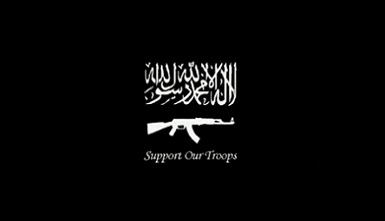
Note also that the filmmaker’s ironic borrowing of the phrase “Support Our Troops” to urge support of the troops of the Mahdi will not be lost on some viewers.
This screen-capture, from the United States of Islam video, in turn reminded reminded me of the Saudi flag, which likewise carries the shahada or Muslim profession of faith and a weapon a sword.
According to a note on an earlier version of the World Flag Database:
The script in the centre of the flag is the Islamic creed, “There is no God but Allah, and Mohammed is the Prophet of Allah”. The flag is therefore considered sacred and special protocol rules apply: the flag does not dip in salute, nor is it ever flown at half-mast. Note that the creed always reads properly from right to left, with the sword hilt to the right, so the reverse of the flag is not a mirror image of the obverse. When making the flag, the creed must be reproduced precisely, including the accent marks. The use of the flag on any commercial item (especially clothing) is not recommended as it might be considered inappropriate, or even insulting.
The Shahada is the central testament of faith of Islam, as is the Shema Yisroel of Judaism and the Credo of Christianity, and I respect it as such — and likewise the Saudi flag., on which it is displayed.
*
Flags, however, are potent symbols, and the graphical power of the “black flags of Khorasan” motif should not, in my view, be underestimated. The particular video that I took that screen-capture from makes use of “mix” flags of its own devising:
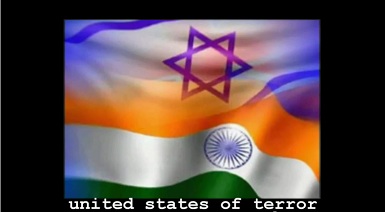
— merging the American and Indian flags or the flags of India and Israel
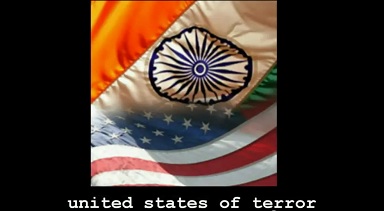
to create an imagery of the “United States of Terror” to juxtapose against their own black flags as the “United States of Islam” giving us Huntington’s “Clash of Civilizations” in visceral graphic form.
And that conjunction of India with Israel bears thinking about, too… not only in terms of military aid between the two nations, but also of the symbolic juxtaposition of the Al-Aqsa Mosque and Jerusalem with the Babri Masjid and Ayodhya…
Indeed, the Indian flag itself also deserves consideration in our context.
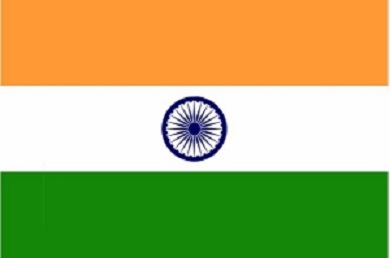
Originally, Mahatma Gandhi had hoped that it would feature the charka or spinning wheel which he had made famous. As an informative article on the subject from The Hindu puts it:
For Gandhiji, the charka represented not a mere hand-spinning device that could provide employment and income to the poor, but much more. “The message of the spinning-wheel is much wider than its circumference. Its message is one of simplicity, service of mankind, living so as not to hurt others, creating an indissoluble bond between the rich and the poor, capital and labour, the prince and the peasant.” (Young India, September 17, 1925). “Above all, charka is a symbol of non-violence” (Collected Works of Mahatma Gandhi, Vol. 71, first edition, p.234).
Gandhiji was, therefore, all the more sad when a correspondent from Hyderabad brought to his notice, on the eve of Independence, K. M. Munshi’s indictment in his broadcast speech that the wheel in the new flag represented the Sudarshana Chakra (discus of Lord Vishnu), a symbol of violence! But Gandhiji consoled himself that “under no circumstances, can the Asoka Chakra become a symbol of violence as Emperor Asoka was a Buddhist and a votary of non-violence” (Harijan Sevak, August 17, 1947).
So there’s another weapon-flag connection — albeit one where non-violence seems to triumph over violence.
*
But let me get back to the yellow Hizbollah flag with which we started, and quickly note the resemblance (which I don’t claim to be the first to note, but cannot presently find my source for) between its portrayal of a rifle raised in a victorious fist, and this poster from the Irgun:
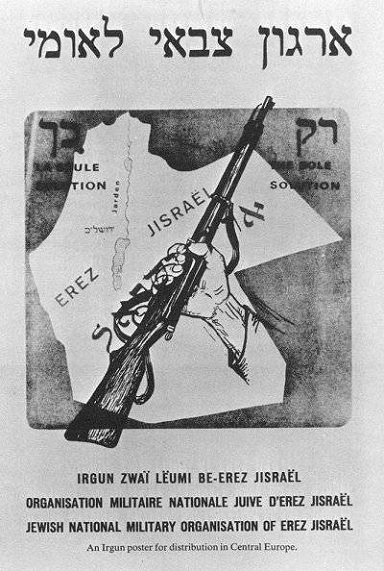
And that’s enough about weaponry and flags for now, I think.
I hope to follow this post up shortly with a more detailed account of the United States of Islam video mentioned above, and its many and curious references and resonances.
I took a geography course at college called Geography of the Islamic World not long after 9/11. The professor challenged the class to ask themselves why the Islamic world was looked at as a militantly belligerent, where westerners get the perception that Islam exists behind a face of scimitar wielding warriors. On the wall around the class were some of the flags of Islamic nations . . . like the flag of Saudi Arabia. Right. I wonder.
I find what is significant is that there is no image of OBL. What do you think, or did I miss something?
The Shahada is the central testament of faith of Islam, as is the Shema Yisroel of Judaism and the Credo of Christianity, and I respect it as such ”” and likewise the Saudi flag
Respect in what sense? You can’t believe all three. Do you respect the Hezbollah flag? As you note, it has Arabic scribbling and a weapon too.
What would a religion have to do to lose your respect?
The first thing I thought of when I saw that Hizbollah flag is a discussion I had some years ago, during the Israel-Lebanon flare-up of the ‘oughts.
I was noting a long-standing “peace group” in Britain, the ‘Women of Greenham Common’ (a NATO base), formed during the Reagan era to oppose that monster cowboy and his nuclear six-shooters, blah blah blah.
So there they are, still around, a European (sic) “peace” group, (so naturally they despise the state of Israel and would like to see them all killed, we all know the drill…)
And there they are, marching around to protest Israel, under Hezbollah flags…. with a freekin’ machine gun on it!! Yeppers, all about peace, as we fly the banner of the AK-47.
I could say, “that’s when I realized….” but I realized long before that, so it just hammered home how contemptible so many of these “peace” activists really are, and how astonishingly blind that not even one of them might say “hey, wait a minute” before marching under the banner of the machine gun in the name of peace.
So, as before and after, essentially, whatEVER such people are for, I will oppose, whatEVER they oppose I will support, and I always wind up right to do so.
It does simplify matters somewhat, I’ll give them that.
My interest in the Hezbollah flag arises because Abu Muqawama mentioned it in a post recently, and quoted an NY Times interview with CJ Chivers on the topic of the AK-47, which included the question, “Are there any other examples of weapons being national symbols?”
This reminded me of the Saudi flag — and I happened to stumble across both the “black flag of Khorasan” and the Irgun poster in miscellaneous research the same day. I’m interested in symbolism and graphics, and the topic of flags and weaponry struck me as worth a little research.
What interests me a great deal more, though, is Islamic eschatology – which is what those “black flags of Khorasan” are all about — and it’s my impression that we know far too little about it. That’s a topic that I hope to explore in the posts to follow this one…
Curmudgeon:
The flag of the City of London carries a sword, apparently representing the sword with which St Paul was beheaded. My home city, Oxford, is known for its “dreaming spires” – much more to my own taste.
BGates:
I treat the symbols of the religions and nations of others as I would hope they would treat mine: with respect.
Your question, “What would a religion have to do to lose your respect?” is an interesting one. I suppose it would have to show me no trace of anything that brings me inspiration — in its music, its architecture, its philosophy, its literature, its sciences… and in my friends of that faith.
Andrew X:
A “peace” group which would like to see all the Israelis killed is an Orwellian peace group. I prefer my language straight up, and my Israeli friends in good health.
Larry:
When you say “there is no image of OBL” are you referring to the video? As I hope to show, it’s quite a hodgepodge ideologically and strategically speaking.
“… reminded me of the Saudi flag, which likewise carries the shahada or Muslim profession of faith and a weapon – a sword.”
Sure, it is a sword. But it is also a bayonet. A sword bayonet. Can be used as a short sword all by itself, but was intended to be mounted on a rifle.
http://en.wikipedia.org/wiki/Sword_bayonet
Just by the shape, it appears to be a French pattern. But, in all fairness, just about every sword bayonet manufactured after the Napoleonic Wars mimicked the French design.
This doesn’t do anything to invalidate the points made in your excellent post, of course. It just seems that the designers of the Saudi flag were using imagery that suggested the high water mark of the Caliphate, while still urging believers to take up modern arms in defense of the newly formed state.
Thanks, James.
Here’s an earlier version of the flag:
Would that be a scimitar?
Apologies — the image doesn’t seem to have come through. Here’s the link.
And since that’s just an image, here’s a link to the history behind it, Wikipedia-style.
@ James Rummel: Can you provide a citation that shows Saudi intent to use a sword-bayonet? Saudis tell me it’s just the modern version of what used to be a scimitar. The hand guard, as displayed on the flag, does not seem to include any device for attachment to a rifle.
Charles, “showing no trace of anything” inspirational is an awfully low bar. The Aztec cults that murdered and cannibalized victims in the thousands built lovely shrines. I think your rendition of the Golden Rule is mistaken as well. If you had the misfortune to live under the Khmer Rouge, would you have wanted others to treat your flag with respect?
The Irgun poster is a pretty good analogue to the Hezbollah flag, showing the symbol of one of several competing pre-state Zionist groups (and copied by today’s marginal JDL). Once the Jews got a state the Irgun was subsumed into democratic politics. The use in the Israeli flag of a Magen David (hexagram), a symbol of Judaism, rather than a weapon, is similar to the use of crosses and crescents in the flags of modern Christian and Muslim nations (Saudi Arabia being a notable exception and perhaps there are others). Would a Hezbollah state have a different flag than the current Hezbollah flag?
BGates writes:
Well, I suppose the question would come up: what constitutes a religion – and what constitutes a valid “version” of that religion?
As a scholar, I am not convinced that we know exactly what Jesus taught – the documents we have were written several decades after the conversations and events they report, and seem to indicate that even his own immediate followers had a hard time grasping his meaning. There’s a huge body of tradition that follows on from those conversations, texts and events, though – and while there is much in there that distresses me, there is also a very great deal to be thankful for.
My own “takeaway” comes mainly from the Beatitudes, and from the teachings of my mentor, Fr. Trevor Huddleston. For now, let me just say that this leaves me closer in empathy to St Francis in his dialogue with the Sultan Malik al-Kamil than with St Bernard in his preaching of the crusades.
I have some admiration for Nahuatl poetry, but no relish for cutting out hearts as offerings to the sun. I would hope that if I lived under the Khmer Rouge, I would stand against the regime, as Huddleston stood against apartheid
Jonathan:
Yes – the use of the Magen David on the Israeli flag is in this sense also similar to the use of the Dharma Chakra on the Indian.
The question of whether a “Hezbollah state” (in Lebanon?) would have a different flag is intriguing – one might hope that the cedar of the current Lebanese flag would replace the raised fist and rifle…
Regarding what you refer to as the “charka”, I believe you meant chakra. Wheel.
As to Mohanandas Gandhi, he – and the policies he espoused and were adhered to after his death by Nehru and Indira Gandhi (no relation) – held the genius of India back for 50 years. It would have been on a par with the United States by now had not this posturing, foolish socialist not had the ear of Prime Minister Nehru and Nehru’s daughter Indira, who respected him because she’d grown up with him always being around. He was a pain in the neck.
Had he not tiresomely advocated “a spinning wheel in every home”, India would have been exporting their cotton. As it was, the ports and roads to the ports never got developed. The world was hungry for Indian cotton.
As an aside, India now is third in the world in applications for patents on original technology, just behind the US and Germany.
Hi Verity:
Not so – the charka (also spelled charkha) is the spinning wheel, a chakra is a wheel or disk.
I find Gandhi to be an inspiring figure, in much the same way as I do St Francis. But I’m not convinced that visionaries necessarily make the best executives…
Ghandiji was a great but flawed man, but his greatness outweights the flaws. By channeling the rising tide of Indian nationalism into peaceful rather than violent channels, he helped bring about the exit of Britain without armed resistance, which was far from inevitable. Most of the bloodshed associated Britain’s exit was due to partition, which he opposed. He raised a generation of activists who founded a constitutional democratic republic which survives to this day. His economic ideas were not sensible, by our standards. But they did not appear completely unreasonable at the time in a country that was primarily composed illiterate villagers eking out a living with very primitive agriculture. But the only alternative on the table at the time was state-centric socialism, which Nehru introduced. We can deplore this, but it was the state of the art thinking at the time, unfortunately. Only tiny minorities of intellectuals were advocating liberal capitalism. Overall, Gandhi was a positive figure, especially when compared to reasonably likely alternatives that did not happen.
Hi, Lex:
There’s a very interesting thread that shuttles across the Atlantic between the Beatitudes, the Bhagavad Gita, Emerson, Thoreau, Gandhi, Smuts, and ML King. I imagine someone has written it all up by now…